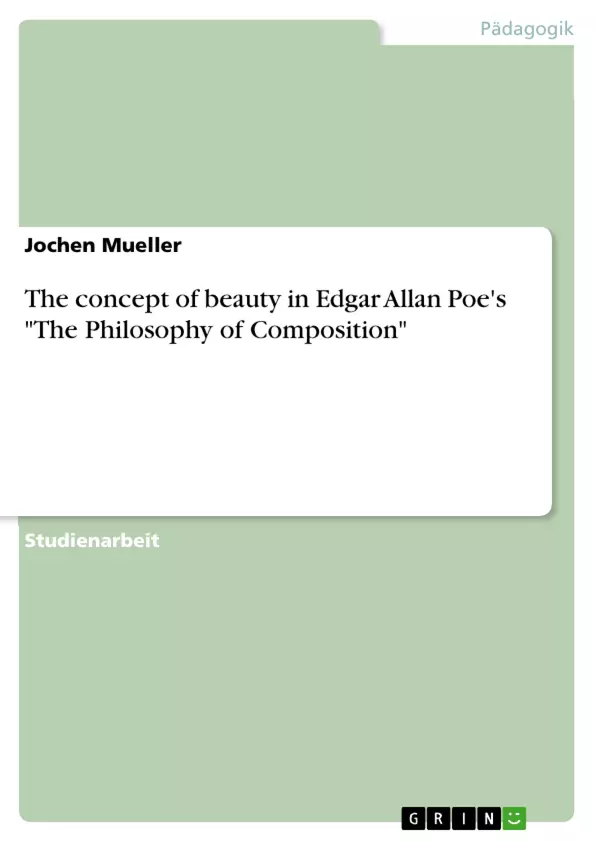This paper provides research into the constituents of Edgar Allan Poe’s concept of beauty by taking into account a selection of his critical essays, among them “The Philosophy of Composition” and “The Poetic Principle.” The final goal is to filter out the essence of Poe’s idea of beauty. Furthermore, the author will argue that a coherent concept of beauty exists in the works of Poe. This paper will also consider the works of Poe’s critics who are concerned with his relations to the American press and his dependence on romantic philosophers. After the establishment of a coherent concept of beauty, the author applies it to Poe’s poem “To Helen."
Inhaltsverzeichnis
- INTRODUCTION.
- THE SUPERIORITY OF POETRY?
- POE'S CONCEPT OF BEAUTY
- BEAUTY, BEAUTIFUL AND THE SUPERNAL BEAUTY?
- THE FACULTY OF IDEALITY
- TASTE
- MUSIC AND POETRY.
- MELANCHOLY……………………………...
- FANCY AND OR FANCY VERSUS IMAGINATION?
- TO HELEN - AN APPROACH..
- CRITICISM...
Zielsetzung und Themenschwerpunkte
Diese Arbeit befasst sich mit der Konzeption von Schönheit in den literaturkritischen Schriften von Edgar Allan Poe, insbesondere in Bezug auf seine Definition von Poesie. Ziel ist es, die Bestandteile von Poes Konzept der Schönheit zu untersuchen, seine Verbindung zu philosophischen Strömungen der Romantik und seine Anwendung auf ein konkretes Gedicht zu analysieren.
- Poes Definition von Poesie als "rhythmische Schöpfung der Schönheit" und seine Hierarchie der Kunstformen
- Die Bedeutung von Musik und Rhythmus in Poes Konzept der Schönheit
- Die Abgrenzung von Wahrheit und Schönheit in Poes Poetik
- Der Einfluss von philosophischen Strömungen wie der Romantik und dem Ästhetizismus auf Poes Werk
- Die Anwendung von Poes Konzept der Schönheit auf ein konkretes Gedicht
Zusammenfassung der Kapitel
- Kapitel 1: Einleitung: Diese Einleitung stellt Edgar Allan Poe als Schriftsteller, Kritiker und Erfinder der Detektivgeschichte vor. Sie beleuchtet Poes eigenständigen Stil der Literaturkritik und seine Entwicklung von Theorien zur Beurteilung literarischer Werke. Insbesondere wird die zentrale Rolle der Schönheit in Poes Poetik hervorgehoben.
- Kapitel 2: Die Überlegenheit der Poesie?: Dieses Kapitel untersucht Poes Hierarchie der Kunstformen und argumentiert, dass Poesie die höchste Form literarischer Kunst ist. Die Definition von Poesie als "rhythmische Schöpfung der Schönheit" wird hier näher beleuchtet, sowie die enge Verbindung von Poesie und Musik.
Schlüsselwörter
Edgar Allan Poe, Schönheit, Poesie, Romantik, Ästhetizismus, Literaturkritik, Rhythmus, Musik, Wahrheit, The Philosophy of Composition, The Poetic Principle, Gothic, Schauerroman, Phrenologie.
- Quote paper
- Jochen Mueller (Author), 2014, The concept of beauty in Edgar Allan Poe's "The Philosophy of Composition", Munich, GRIN Verlag, https://www.grin.com/document/306544



